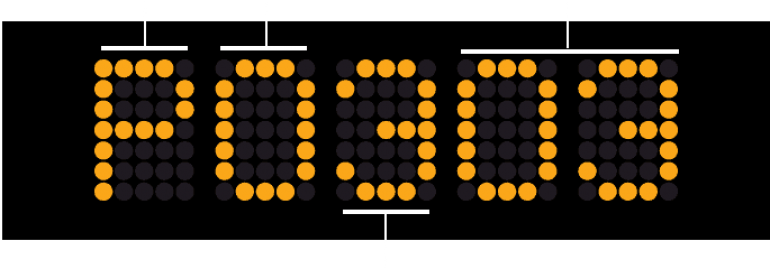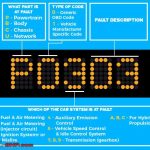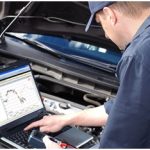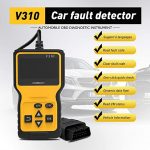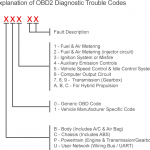If you’re unfamiliar with OBD codes, don’t worry! The first digit of the code will tell you a lot about the fault. It communicates with the Trouble Code Subsystem and will narrow down the problem considerably. It’s also called a code family or a code group. Although OBD codes are specific, they are not always easy to read at a glance. In this article, you’ll learn how to interpret an odb code and determine what it means.
Diagnostic trouble codes
If you notice a check engine light in your vehicle, it might be indicating a problem in the engine management system, or some other function. This light may also indicate a problem with your car’s engine’s diagnostic system, also known as “diagnostic trouble codes.” Diagnostic Trouble Codes, or DTCs, are five-digit codes that identify specific problems within your car. When connected to the OBD system, these codes are displayed on a scan tool. Each DTC represents a specific problem.
Unlike error codes, DTCs can occur for a variety of reasons. Not all problems generate DTCs, and not all of them indicate a serious problem. For example, a DTC might indicate that a sensor circuit has gone out of range, or that an emissions control system component is malfunctioning. While all DTCs require immediate attention, not all of them are critical. You need to know how to interpret the code you see to determine what needs fixing.
Fortunately, a simple way to identify the issue is to read a DTC. A DTC is an alphanumeric code generated by the on-board computer. This code will help you identify which component is failing and need fixing. This process is called OBD2 diagnostics. It will also let you know if your car is suffering from a malfunction. There are hundreds of DTCs in modern vehicles. If you are unsure which DTC your vehicle is emitting, you can use a DTC-reading tool to find out more.
Knowing the DTCs can prevent bigger problems from happening. By understanding the code, you can take control of your car’s maintenance. By taking the lead in the diagnostic process, you can prevent costly mistakes and save money. There’s no need to hire a mechanic when you can perform diagnostics yourself. So, what are diagnostic trouble codes and how do they affect your car? There’s a code reader for nearly every car on the road today!
Meaning of odb codes
OBD2 codes are five-character strings that refer to thousands of different fault codes. A scan tool can retrieve the code and then use it to troubleshoot the vehicle. The first digit of the code specifies what type of fault the car is experiencing. The second digit indicates the particular system in the car that the code refers to. The last two digits denote a specific fault designation. Those are the most common types of fault codes found on cars.
The meaning of an OBD code is an important part of identifying what is causing the Check Engine Light to illuminate. These codes are usually composed of numbers and letters. The first four characters are single numbers, ranging from 0 to 9, while the fifth and sixth characters are pairs of numbers from 00 to 99. It’s important to understand the meaning of each OBD code so you can take immediate action. To learn what the code means, visit an OBD code interpretation website.
When the P0122 code triggers, the TPS voltage is low – possibly as low as 0.20V. This code is caused by faulty wiring or a loose connection. A visual inspection of the wiring may reveal that the connections are not secure and need to be inspected. In addition, a P0131 code indicates a low voltage condition in the bank one sensor. A thorough check of the wiring may be necessary to solve the issue.
If you see an OBD code that has been flashing on your dashboard, it’s time to schedule a repair appointment with a mechanic. OBD trouble codes are a vital part of your car’s self-diagnosis system. They identify the cause of a malfunction and help you determine the best course of action. There are four main systems that use OBD codes, and each one has its own meaning.
Symptoms of odb codes
EVAP codes are an important indicator that your vehicle’s emissions control system isn’t working properly. These codes indicate problems with the vehicle’s EVAP system, which prevents gas fumes from reaching the atmosphere and keeping air pollution to a minimum. Transmission codes monitor the transmission and idling, and are triggered by various problems. The most common cause of transmission codes is faulty computer systems. Diagnosed problems with on-board diagnostic systems are best left to a trained professional.
When the engine misfires, the result is an exhaust gas odor and a low amount of power. Some symptoms of engine misfires are a misfire in cylinder two or a high amount of air in the exhaust gas. The O2 sensor is one of the most important parts of an engine, as it measures air entering the engine. Hence, a malfunction in the IAT sensor can result in a code P0113. Other codes related to engine misfires include P0300-P0312 and P0335-P0339.
The diagnosis of DTCs is essential in restoring a vehicle’s performance. OBD-ll trouble codes were initially developed to help technicians diagnose and repair faulty systems, but there were limitations to their scope. With this in mind, GM created the symptom byte to expand the diagnostic code base. While some manufacturers have adopted enhanced DTCs or symptom bytes, others have not. A scan tool is essential in detecting a DTC.
Understanding the meaning of OBD codes can give you peace of mind and allow you to take action quickly if needed. A properly functioning Check Engine Light will illuminate when an issue has been detected in the monitored system. Using an OBD code reader, you can identify and diagnose the problem. Most diagnostic tools will even tell you the code meaning so you can address the issue before it leads to more expensive repairs. So, knowing your OBD code is crucial in resolving a vehicle problem and finding the right mechanic.
Ways to read odb codes
To understand what the OBD codes in your car mean, you must first understand what the symbols stand for. The codes are made up of a series of letters and numbers, and represent the general cause of the Check Engine Light being illuminated. Single digits ranging from 0 to 9 are used as the basis for the code, followed by a pause. The fourth and fifth characters are also used as the basis for the code, and pairs of numbers ranging from 00 to 99 are also common.
The first code you should look for is “Pending”. It means that the emission control system failed to function properly. Once the same problem happens again, the Check Engine Light will turn on. When the check engine light is illuminated, the pending code becomes an active one. Then, you’ll find the P-code, which covers the engine and transmission, and the DTC, which stands for “Undefined”. You can search for any of these codes online, or read explanations on the device itself.
The second code is P0442. This indicates that the evaporative emissions system has a leak. When a P0442 is displayed, it means that the evaporative emission system has a problem. When you look for this code, you will be able to figure out what the problem is. You can also get a list of problems that may be causing the P0442 code. In this way, you can know what the problem is and how to fix it.
The third way to read the ODB codes is to read the information provided in the on-board diagnostic system of your car. Most of the time, the check engine light on your car will indicate a problem with the gas cap or the engine. If you don’t know the code, you can consult a mechanic. These codes will give you valuable information on what is wrong with your vehicle. You can also read the codes on your own to identify any problems that your car has.
Apps that can help you read odb codes
Apps that help you read OBD codes are very helpful, but which ones are the best? Below we will look at some of the top choices. One of the best OBD2 readers is Torque Pro. It uses a Bluetooth adapter to connect to your car’s OBD port. The app also includes many useful features such as fault memory and live tracking. It even has a customizable dashboard, so you can see the state of your car at a glance.
Carly. This free app comes with a host of functions and is compatible with most car brands. It allows you to perform basic diagnostics and read OBD2 codes. Carly also has a paid version, which includes in-depth diagnostics, used car check, and auto coding. The free version offers a limited number of features, but it allows you to try out the most important features.
OBDroid. This app is a fault code reader that displays engine speed and airflow, resets the CPU error code, and a few other useful features. It has an enormous database and can lookup fault codes from domestic and import car manufacturers. It connects to OBD2 devices via Bluetooth, and works with cheap ELM327 Bluetooth adapters. It connects and works flawlessly.
OBD Auto Doctor. This is an OBD code reader for your Android or iOS smartphone. It is compatible with most vehicles that have an OBDII Bluetooth adapter. It’s compatible with most cars made after 2000. This app consumes quite a bit of battery power, but it does give you a great idea about your car’s health. You might want to try this app before you spend any money on a repair.


